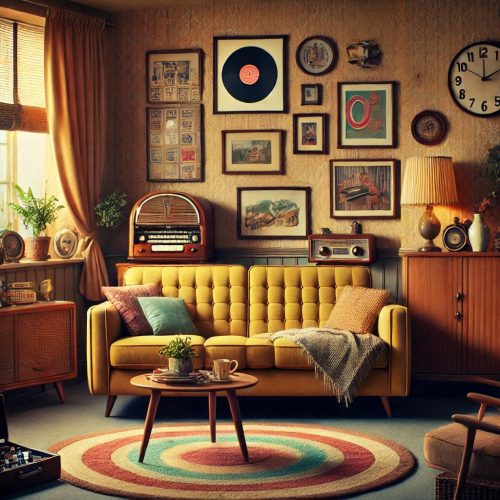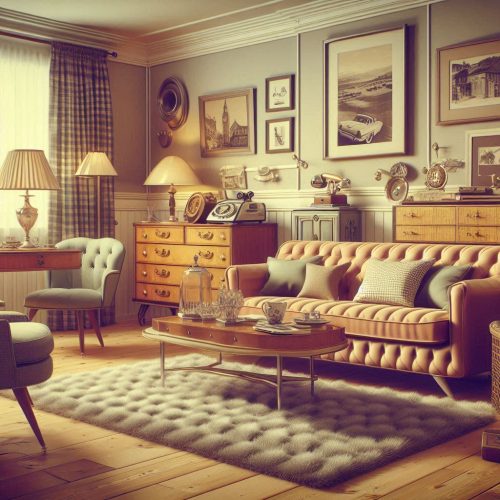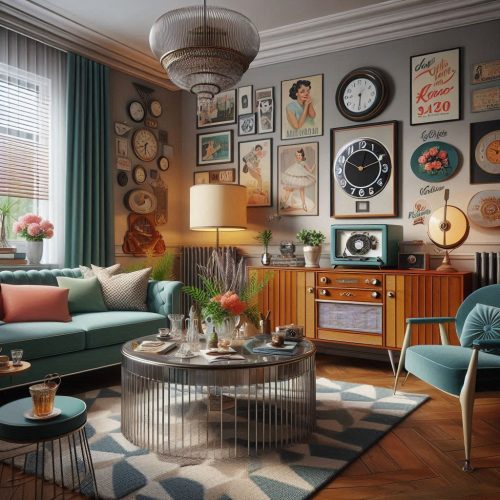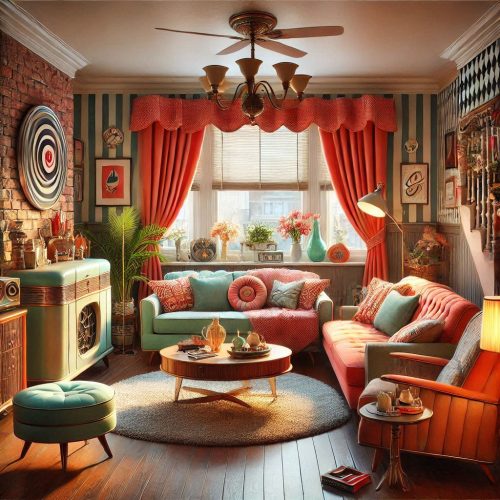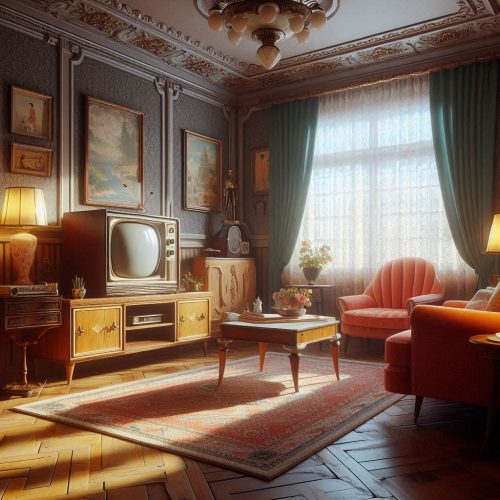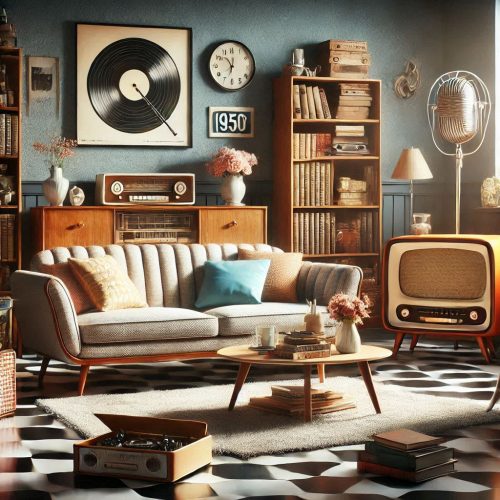The 1950s living room design is a celebration of boldness, elegance, and innovative design. During this era, American households embraced a sense of optimism and prosperity, and the living room became a focal point of social life. Combining mid-century modern furniture with whimsical colors, patterns, and textures, the 1950s style is timeless and continues to influence modern interiors today. The room exudes a balance of functionality, comfort, and visual appeal. Let’s explore how you can create a 1950s living room that brings the past into the present.
Mid-century Modern Furniture: The Heart of the 1950s Living Room
At the core of 1950s living room design is mid-century modern furniture, which features clean lines, geometric shapes, and minimal ornamentation. Popular pieces include sleek, wooden coffee tables, low-profile sofas, and iconic lounge chairs, such as the Eames Lounge Chair. Furniture from this period often utilized organic shapes, contrasting materials like wood and metal, and functional design elements. Incorporating mid-century modern furniture ensures your space feels authentic while maintaining a balance between practicality and aesthetic appeal.
Bold and Playful Color Palette
The 1950s living room was known for its bold use of color, often mixing vivid tones with neutral backdrops. Pastels such as mint green, baby blue, and pale yellow were paired with stronger colors like rich red, orange, and turquoise. The retro color palette contributed to a lively, playful vibe, making the space feel inviting and cheerful. For a more contemporary take, you can still use these bold colors on accent walls, throw pillows, or rugs to evoke the spirit of the era. Retro color schemes like these instantly transform a modern living room into a nostalgic retreat.
Vintage Patterns and Textures
Patterns were an essential part of 1950s living room design, ranging from abstract geometric prints to floral designs. Retro patterns like chevrons, circles, and diamond shapes can be incorporated into your sofa upholstery, rugs, or curtains. These patterns are paired with rich textures, such as velvet, tweed, and tweed-like fabrics, which were common for upholstery during the era. Adding vintage textiles to your living room will infuse it with a tactile appeal, creating an atmosphere of cozy nostalgia.
Iconic Lighting Fixtures for a Retro Feel
Lighting was an essential element in the 1950s living room design. Iconic lighting fixtures like the starburst chandelier or the atomic pendant light created a focal point in the room. These fixtures featured intricate designs with metallic finishes that complemented the geometric shapes seen in furniture and accessories. To replicate the style, you can opt for retro lighting with mid-century modern characteristics such as sputnik chandeliers, brass floor lamps, and table lamps with bold, sculptural designs. These lighting pieces contribute both function and artistry to the space.
Decorative Accessories and Collectibles
To complete the 1950s living room design, add retro accessories and collectibles that reflect the era’s cultural milestones. Ceramic figurines, vintage radios, and patterned vases were common during this time. Accessories like mid-century modern clocks, glassware, and decorative bowls brought a touch of personality and playfulness to the room. Vintage knick-knacks can be displayed on shelves or coffee tables to infuse character and charm into the space. These nostalgic items evoke the atmosphere of the 1950s and personalize the living room.
Open and Airy Layout
A defining characteristic of 1950s living room design is its open and airy layout. Rooms were often designed to be functional and spacious, with furniture arranged to encourage conversation and gatherings. Large windows let in natural light, creating an open, welcoming environment. To emulate this, consider an open floor plan with minimalistic furniture arrangements that encourage flow and interaction. By keeping the space clutter-free and opting for functional furniture, you can achieve a retro-inspired, spacious look that still feels modern and comfortable.
Sleek Wood and Metal Elements
Incorporating both wood and metal elements is key to achieving a 1950s living room look. Wooden accents, such as coffee tables, sideboards, and bookshelves, are often paired with sleek metal elements like legs and frames. The combination of organic wood tones with polished metal finishes adds a timeless sophistication to the space. Mid-century modern tables with metal legs or wooden TV stands with metal touches evoke the perfect balance between form and function. These materials are a signature feature of retro design, providing a clean and refined look.
Classic Upholstery Styles with a Modern Twist
The 1950s living room design is all about contrast – traditional meets modern. Classic upholstery styles like tufted backs, sleek leather finishes, and patterned fabrics can be blended with contemporary materials. Opt for retro-inspired sofas with low, angular frames or rounded edges to achieve the vintage look while maintaining modern comfort. If you’re going for a more authentic 1950s vibe, you can find vintage-inspired couches that evoke the spirit of the era. Pairing these with modern touches such as minimalist coffee tables or abstract artwork keeps the space from feeling outdated.
Retro Wall Art and Accent Pieces
Retro wall art was an essential element in the 1950s, showcasing everything from abstract expressionism to playful advertisements and illustrations. To integrate this into your 1950s living room design, consider vintage prints or bold, geometric wall art that adds visual interest to your space. Another popular feature was the use of mid-century modern mirrors, which often had unique shapes like ovals or sunbursts. These art pieces add a pop of personality to the room while staying true to the retro aesthetic.
Personalizing with Modern Retro Fusion
While it’s important to capture the essence of the 1950s living room, infusing the space with your personality is essential. You can mix vintage and modern elements to create a fusion of past and present. A modern sofa with retro-inspired pillows, or an antique lamp paired with a contemporary coffee table, can make the room feel personal yet stylish. By balancing nostalgic touches with updated furniture, you create a living space that feels timeless and contemporary at the same time, perfect for today’s lifestyle.
Embracing the 1950s living room design is all about blending mid-century modern charm with bold colors, intricate patterns, and vintage accents. Whether you’re looking to bring back the playful spirit of the 1950s or simply infuse your living space with retro flair, the timeless appeal of this design will never go out of style. By incorporating retro furniture, mid-century modern decor, and vintage accessories, you can create a living room that is both nostalgic and modern, perfect for today’s homes.

